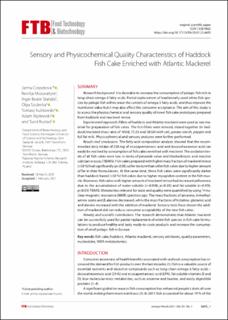| dc.contributor.author | Cropotova, Janna | |
| dc.contributor.author | Mozuraityte, Revilija | |
| dc.contributor.author | Standal, Inger Beate | |
| dc.contributor.author | Szulecka, Olga | |
| dc.contributor.author | Kulikowsk, Tomasz | |
| dc.contributor.author | Mytlewski, Adam | |
| dc.contributor.author | Rustad, Turid | |
| dc.date.accessioned | 2021-03-19T11:44:57Z | |
| dc.date.available | 2021-03-19T11:44:57Z | |
| dc.date.created | 2021-02-07T16:01:49Z | |
| dc.date.issued | 2021 | |
| dc.identifier.issn | 1330-9862 | |
| dc.identifier.uri | https://hdl.handle.net/11250/2734466 | |
| dc.description.abstract | Research background. It is desirable to increase the consumption of pelagic fish rich in long-chain omega-3 fatty acids. Partial replacement of traditionally used white fish species by pelagic fish will increase the content of omega-3 fatty acids, and thus improve the nutritional value but it may also affect the consumer acceptance. The aim of this study is to assess the physicochemical and sensory quality of novel fish cake prototypes prepared from haddock and mackerel mince.
Experimental approach. Fillets of haddock and Atlantic mackerel were used as raw material for preparation of fish cakes. The fish fillets were minced, mixed together (in haddock/mackerel mass ratio of 100:0, 75:25 and 50:50) with salt, potato starch, pepper and full fat milk. Physicochemical and sensory analyses were further performed.
Results and conclusions. The fatty acid composition analysis showed that the recommended daily intake of 250 mg of eicosapentaenoic acid and docosahexaenoic acid can easily be reached by consumption of fish cakes enriched with mackerel. The oxidation levels of all fish cakes were low in terms of peroxide value and thiobarbituric acid reactive substance assay (TBARS). Fish cakes prepared with higher mass fraction of mackerel mince (>50 %) had significantly (p<0.05) softer texture than other fish cakes due to higher amount of fat in their formulations. At the same time, these fish cakes were significantly darker than haddock-based (>50 %) fish cakes due to higher myoglobin content in the fish muscle. Moreover, fish cakes with higher amount of mackerel mince had increased yellowness due to the accumulation of water-soluble (r=0.990, p<0.05) and fat-soluble (r=0.976, p<0.05) TBARS. Metabolites relevant for taste and quality were quantified by using 1H nuclear magnetic resonance (NMR) spectroscopy. The mass fractions of anserine, trimethylamine oxide and β-alanine decreased, while the mass fractions of histidine, glutamic acid and alanine increased with the addition of mackerel. Sensory tests have shown the addition of mackerel did not reduce consumer acceptability of the new fish cakes.
Novelty and scientific contribution. The research demonstrates that Atlantic mackerel can be successfully used for partial replacement of white fish species in fish cake formulations to produce healthy and tasty ready-to-cook products and increase the consumption of small pelagic fish in Europe. | en_US |
| dc.language.iso | eng | en_US |
| dc.publisher | Food Technology and Biotechnology (FTB) | en_US |
| dc.rights | Navngivelse 4.0 Internasjonal | * |
| dc.rights.uri | http://creativecommons.org/licenses/by/4.0/deed.no | * |
| dc.title | Sensory and Physicochemical Quality Characteristics of Haddock Fish Cake Enriched with Atlantic Mackerel | en_US |
| dc.type | Peer reviewed | en_US |
| dc.type | Journal article | en_US |
| dc.description.version | publishedVersion | en_US |
| dc.source.volume | 59 | en_US |
| dc.source.journal | Food technology and biotechnology | en_US |
| dc.source.issue | 1 | en_US |
| dc.identifier.doi | https://doi.org/10.17113/ftb.59.01.21.6695 | |
| dc.identifier.cristin | 1887432 | |
| cristin.ispublished | true | |
| cristin.fulltext | postprint | |
| cristin.qualitycode | 1 | |

